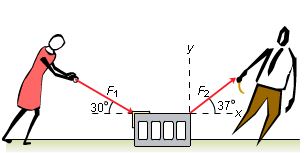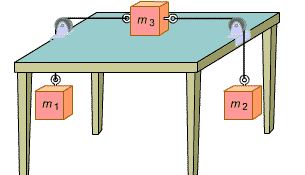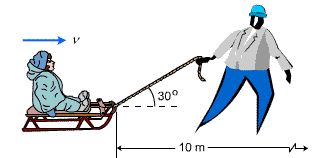Discuss the below:
1: A packing crate is placed on a plane inclined at an angle of 35o from horizontal. If the coefficient of static friction between the crate and the plane is 0.65, will the crate slide down the plane? Justify your answer.
2: For the situation shown in the figure, what is the minimum coefficient of static friction between the block and the surface that will keep the block from moving? (F1 = 5.0 N, F2 = 4.0 N, and m = 5.0 kg.)

3: If the coefficient of kinetic friction between the block and the table in the figure below is 0.560, and m1 = 0.150 kg and m2 = 0.250 kg (a) what should m3 be if the system is to move with a constant speed? (b) If m3 = 0.100 kg, what is the magnitude of the acceleration of the system? (Assume ideal conditions for the string and pulleys.)

4: A father pulls his young daughter on a sled with a constant velocity on a level surface through a distance of 10 m, as illustrated below. If the total mass of the sled and the girl is 35 kg and the coefficient of kinetic friction between the sled runners and the snow is 0.20, how much work does the father do?

5: A student could either pull or push, at an angle of 30o from the horizontal, a 50-kg crate on a horizontal surface, where the coefficient of kinetic friction between the crate and surface is 0.20. The crate is to be moved a horizontal distance of 15 m.
(a) Compared with pushing, pulling requires the student to do (1) less, (2) the same, or (3) more work.
(b) Calculate the minimum work required for both pulling and pushing.
6: A particular spring has a force constant of 2.5 X 103 N/m.
(a) How much work is done in stretching the initially-relaxed spring by 6.0 cm?
(b) How much more work is done in stretching the spring an additional 2.0 cm?
7: Levers, pulleys, and wedges are simple machines. Does the concept of work explain why we use these machines in our daily lives, how they work, and why they work? Explain your reasons in two paragraphs, taking examples from daily life.
8: For identical materials, the static coefficient cannot be greater than kinetic
True or False
9: A wooden block slides directly down an incline plane, at constant velocity of 6.0 m/s. How large is the coefficient of the kinetic friction, if the plane makes an angle of 25 degrees with the horizontal?
A. 0.47
B. 0.42
C. 0.91
D. 0.37
E. 2.1
10: Consider a plot of the displacement on the y- axis vs. applied force on the x-axis for an ideal elastic spring. The slope of the curve would be:
A. the spring is constant
B. the reciprocal of the spring constant
C. the reciprocal of the acceleration of gravity
D. the acceleration of gravity
11: You lift a 10. lb physic book up in the air a distance of 1 ft., at a constant velocity of 0.5 ft./s the work is done by gravity.
A. Zero
B. +5 ft. lb.
C. +10 ft. lb
D. - 10 ft. lb
E. - 5 ft. lb
12: To push a piece of heavy furniture across the carpet usually takes more force to get it moving than it takes to keep it moving. That is because
A. the kinetic coefficient of friction is larger than static coefficient
B. of Newton's Third Law
C. It does not take more force
D. The static coefficient of friction is larger than kinetic coefficient
13: The kinetic friction of one metal object sliding along another metal surface depend least upon.
A. the coefficient of kinetic friction
B. the normal force
C. the nature of the materials in contact
D. the area of contact
14: A packing car slides down an incline at a constant velocity. Thus we can deduce that:
A. a net downward force is acting on it
B. it may be accelerating
C. a frictional force is acting on it
D. it is not acted on by an appreciable gravitational force
15: Which of the following is not an unit of work
A. N-m
B. KW-h
C. J
D. W-s
E. Kg-m/s
16 Two men, Joel and Jerry , push against a immovable wall. Jerry stops at 10 minutes , while Joel is able to push another 5 minutes longer. Compare the work they do:
A. Jerry does 50% more work than Joel
B. Joel does 50% more work than Jerry
C. Neither of them do anymore work
D. Joel does 75% more work than Jerry
17: A 10.0 Kg mass, hung onto a spring , causes the spring to stretch 2.0 cm. the spring is constant is:
A. 0.020 N/cm.
B. 49 N/cm
C. 20.0 N/cm
D. 5.0 N/cm
E. 0.20 N/cm